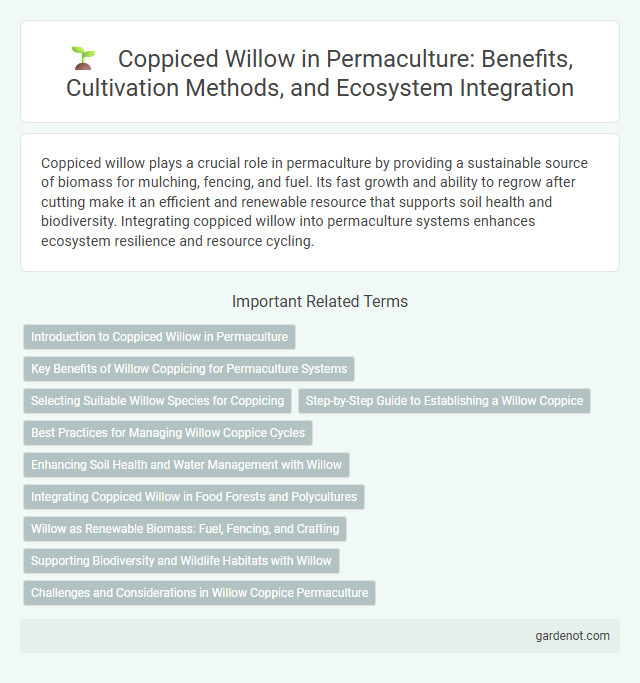Coppiced willow plays a crucial role in permaculture by providing a sustainable source of biomass for mulching, fencing, and fuel. Its fast growth and ability to regrow after cutting make it an efficient and renewable resource that supports soil health and biodiversity. Integrating coppiced willow into permaculture systems enhances ecosystem resilience and resource cycling.
Introduction to Coppiced Willow in Permaculture
Coppiced willow is a sustainable forestry technique widely used in permaculture for its rapid regrowth and versatile applications, including biofuel, basketry, and soil erosion control. This method involves periodically cutting willow stems near ground level to encourage vigorous new growth, enhancing biomass production without replanting. Integrating coppiced willow into permaculture systems supports biodiversity, improves soil health, and provides renewable resources with minimal environmental impact.
Key Benefits of Willow Coppicing for Permaculture Systems
Coppiced willow enhances soil fertility through its rapid biomass production and nitrogen-fixing properties, promoting sustainable nutrient cycling in permaculture systems. Its flexible stems provide renewable materials for fencing, basketry, and erosion control, reducing the need for external resources. Willow coppicing supports biodiversity by creating diverse habitats for pollinators and beneficial insects, strengthening ecosystem resilience.
Selecting Suitable Willow Species for Coppicing
Selecting suitable willow species for coppicing involves prioritizing fast-growing varieties such as Salix viminalis, Salix purpurea, and Salix alba, which exhibit high regrowth rates and durable stems. These species thrive in moist soil conditions and provide optimal biomass yield for sustainable wood production. Proper species selection enhances the efficiency of coppicing systems in permaculture by ensuring rapid regeneration and long-term resource availability.
Step-by-Step Guide to Establishing a Willow Coppice
Select a sunny site with well-drained soil to plant willow cuttings, ideally in early spring when sap flow begins. Insert healthy hardwood cuttings, about 30-50 cm long, into the ground at a 45-degree angle, spacing them 20-30 cm apart in rows separated by 1 meter for easy access. Maintain the coppice by cutting stems close to ground level every 1-3 years, which promotes vigorous regrowth and maximizes sustainable biomass production.
Best Practices for Managing Willow Coppice Cycles
Maintaining optimal growth in willow coppice cycles requires regular harvesting every 2 to 3 years to promote vigorous regrowth and maximize biomass yield. Implementing rotational cutting patterns ensures continuous production while preserving soil health and biodiversity within the permaculture system. Monitoring moisture levels and preventing pest infestations further enhance the sustainability and productivity of willow coppice management.
Enhancing Soil Health and Water Management with Willow
Coppiced willow plays a vital role in permaculture by enhancing soil health through its extensive root system, which improves soil structure and increases microbial activity. The fast-growing willows contribute to efficient water management by stabilizing soil and reducing erosion along waterways. Their ability to absorb excess nutrients and water helps maintain balanced moisture levels, promoting resilient and productive ecosystems.
Integrating Coppiced Willow in Food Forests and Polycultures
Coppiced willow plays a vital role in enhancing food forests and polycultures by providing sustainable biomass for mulch, animal fodder, and natural biofilters. Its fast-growing nature and ability to regenerate after cutting improve soil health and increase biodiversity, creating resilient ecosystems. Integrating coppiced willow supports nutrient cycling and microhabitats, boosting overall productivity in permaculture designs.
Willow as Renewable Biomass: Fuel, Fencing, and Crafting
Coppiced willow serves as an efficient source of renewable biomass, offering rapid regrowth and high-yield wood suitable for sustainable fuel production. The flexible yet durable branches are ideal for constructing natural fencing, providing an eco-friendly alternative to conventional materials. Willow wood also supports various traditional crafts, enhancing the value of permaculture systems through multifunctional resource use.
Supporting Biodiversity and Wildlife Habitats with Willow
Coppiced willow creates diverse microhabitats that support insects, birds, and small mammals by providing dense foliage and standing deadwood. Its rapid regrowth after cutting sustains continuous shelter and food sources, promoting year-round biodiversity. Planting willow along watercourses enhances aquatic ecosystems by stabilizing banks and filtering runoff, benefiting amphibians and pollinators.
Challenges and Considerations in Willow Coppice Permaculture
Coppiced willow in permaculture faces challenges including pest management and ensuring sustainable regrowth cycles to maintain soil health and biodiversity. Careful planning is required to balance harvesting frequency with the willow's natural regenerative capacity, preventing overcutting that can lead to weakened plants. Attention to site selection and water availability is critical, as willows thrive in moist soils but can suffer in drought conditions, impacting overall productivity.
Coppiced willow Infographic

 gardenot.com
gardenot.com